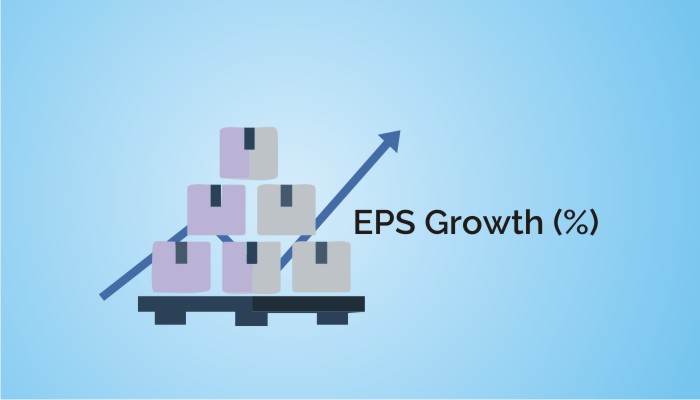How to Analyze EPS Growth for Better Investment Decisions

Earnings per share (EPS) is one of the most fundamental metrics investors use to evaluate a company’s profitability. Understanding EPS growth helps investors determine whether a company is growing sustainably and whether its stock may be a good investment. By analyzing EPS trends, investors can gauge financial performance, compare companies within an industry, and make informed investment decisions. This article explores what EPS growth is, the factors that influence it, how to analyze its trends, and how to use it in investment decisions.
Understanding EPS Growth
EPS growth refers to the increase in a company’s earnings per share over time. It is calculated by taking the company’s net earnings and dividing them by the total number of outstanding shares. Investors often compare current EPS to past periods to determine if a company is growing its profits efficiently.
A strong EPS growth rate generally indicates a company is improving its financial performance. However, it’s important to differentiate between growth driven by increased revenues and that which results from share buybacks or accounting adjustments. While a rising EPS figure may seem positive at first glance, a deeper analysis is required to determine whether the growth is sustainable.
Comparing EPS to revenue growth is another essential aspect of analysis. If revenue is rising alongside EPS, it suggests a healthy business expansion. However, if EPS grows while revenue remains stagnant or declines, it could indicate cost-cutting measures or share repurchases rather than true business growth. To get started, click for details.
Factors Affecting EPS Growth
Revenue growth plays a significant role in EPS expansion. When a company increases its sales, it generates more income, which can lead to higher earnings per share if costs are managed effectively. A business that consistently boosts its revenue while maintaining or improving profit margins is likely to experience strong EPS growth.
Operating efficiency is another crucial component. Companies that optimize their operations, reduce expenses, and improve productivity can achieve higher profitability without necessarily increasing sales. This efficiency-driven EPS growth is often more sustainable than that resulting from short-term financial tactics.
Share buybacks can also impact EPS growth. When a company repurchases its shares, the total number of outstanding shares decreases, making the EPS figure appear higher even if overall earnings remain the same. While this can be beneficial in some cases, excessive reliance on buybacks may indicate a lack of investment in business expansion.
Analyzing EPS Growth Trends
A thorough analysis of EPS growth involves looking at both historical trends and future projections. Reviewing a company’s EPS over multiple years can reveal patterns of consistent growth or highlight fluctuations that may warrant further investigation. Companies with a stable or steadily increasing EPS tend to be more attractive to long-term investors.
Projected EPS growth is another critical factor. Analyst forecasts provide insights into a company’s expected earnings performance in the coming quarters or years. However, it is essential to consider the credibility of these projections. Investors should examine factors such as market conditions, management guidance, and industry trends to determine whether future EPS growth estimates are realistic.
Comparing a company’s EPS growth to that of its competitors offers valuable context. If a company’s EPS is growing faster than its industry peers, it may indicate a competitive advantage or superior management. Conversely, if a company’s EPS is lagging behind industry averages, it could signal underlying issues that need further scrutiny.
Red Flags to Watch for When Analyzing EPS Growth
Declining or erratic EPS growth can be a warning sign. If a company experiences frequent drops in EPS or unpredictable earnings patterns, it may suggest operational inefficiencies, shifting market conditions, or financial mismanagement.
Unjustified EPS growth is another concern. Companies that rely heavily on share buybacks to boost EPS without improving revenue or operational performance may be masking deeper problems. While buybacks can enhance shareholder value in the short term, they should not be the primary driver of earnings growth.
Manipulation of EPS figures through accounting tactics is another risk to watch. Some companies may use aggressive revenue recognition policies or exclude certain expenses from non-GAAP EPS calculations to present a more favourable earnings picture. Investors should carefully review financial statements to identify any discrepancies between reported earnings and actual business performance.
Using EPS Growth in Investment Decisions
EPS growth plays a significant role in stock valuation and investment decision-making. One commonly used valuation metric is the price-to-earnings (P/E) ratio, which compares a company’s stock price to its EPS. A company with strong EPS growth and a reasonable P/E ratio may be a good investment opportunity. However, an excessively high P/E ratio relative to growth could indicate an overvalued stock.
Another useful metric is the PEG ratio, which adjusts the P/E ratio based on expected EPS growth. A PEG ratio below 1 suggests that a stock may be undervalued relative to its growth potential, while a PEG ratio above 1 could indicate an overvaluation.
Conclusion
Analyzing EPS growth is a fundamental part of making informed investment decisions. By understanding what drives EPS growth, recognizing red flags, and using valuation metrics effectively, investors can assess a company’s long-term financial strength and investment potential. Rather than relying on a single indicator, a holistic approach that includes revenue trends, operating efficiency, industry comparisons, and broader financial metrics provides the most accurate picture of a company’s earnings potential.






